Lithium-ion Solar Batteries have become very popular in South Africa for being reliable, safe and having a longer life span than Lead-Acid batteries.
While it may seem daunting right now, our lithium solar battery guide will help you see the light – pun intended!
For your sake (and mine) I’ll skip over the intricate details of how lithium batteries work.
I will, however, explain why the Lithium Iron Phosphate battery is the best choice you can make when buying a storage system.
Here’s what we will cover:
Chapter 1
Lithium-ion Solar Batteries: Fundamentals
In this section, you’ll learn the top 5 fundamentals of lithium-ion batteries.
The Solar industry needed concrete, reliable products that are not only compact but easy to install and operate.
Enter the LiFePO4 Solar Battery .
Watch our short video to understand the fundamentals when choosing a Lithium-ion battery
Lithium Iron Phosphate
Or LiFePO4 for short.
These batteries form part of the newest in Solar Battery technology. They have low toxicity level, well-defined performance and long term stability .
These are a few features that make LiFePO4 batteries the favourite in the solar industry.
From Solar Storage to motor vehicles, their popularity is ever-growing.
kWh – Kilowatt Hour
kWh is a measurement of energy.
It corresponds to using 1kW of power for an hour.
So a 2.4kWh battery means you can run 2400W (2.4kW) of power for an hour.
OR
You can run 1.2kW of power for 2 hours.
What Does DOD Mean?
DOD stands for Depth of Discharge.
Typically, the DOD of LiFePO4 solar batteries is between 80% and 100%. Traditional batteries (Lead-Acid) have a DOD of 50%
Therefore, you can use 80% of the battery daily and still manage to prolong the life of the battery.
What Does Cycle Mean?
Cycles refer to the process of charging and discharging .
When you see “6000 cycles” it means that the battery can be fully charged and discharged 6000 times.
DOD plays a factor in how many cycles you can get out of a single battery if you increase the DOD to 90% your number of cycles decreases.What is the Life Span?
The lifespan of Lithium-ion Solar Batteries is 5000+ cycles. Compared to Lead-Acid batteries which stand at 300 – 1350 cycles.
To work out the life span, take the number of cycles divided by 365 (days in a year):
NB: This is based on one cycle per day.
You can expect a LiFePO4 battery to last upwards of 10 years!
Chapter 2
Lithium-ion Solar Batteries: What About Application?
A bit more in-depth detail

If you need to expand your system, you’d just need to add a new lithium-ion battery at any time .
It is also important to note that you would need to add a battery of the same brand.
With Lead-Acid, you will need to replace the whole battery bank as adding a new battery to an existing set up causes damage to the new batteries.

What are Solar Batteries?
We have a Solar Batteries Guide that will further explain the differences and give you some more information on the Lead Acid batteries that we stock.
Read our Solar Battery GuideLithium-ion Solar Batteries: How Many Lithium-ion Batteries Can I Connect?
Depending on the brand, you can add many batteries together.
The real magic of LiFePO4 solar batteries is that you have the power of choice over the capacity. If you decide to start small, you can always add more batteries as your needs change.
Brand Compatibility
While you can connect two different sized batteries, they will need to be of the same brand.
Safety
Because who doesn’t consider the safety of a product before bringing it into your home?
The LiFePO4 batteries are the safest Lithium batteries in South Africa .
Here’s why:
- They are thermally and chemically stable.
- They stay cool in high temperatures – perfect for South Africa.
- They are incombustible, even when mishandled.
- The Phosphate cathode will not burn or explode .
- They are disposed of far more easily than other batteries because they are nontoxic.
If you’d like to read more about Lithium-ion Solar Batteries, Read our Lithium-ion Battery Guide to visit Wikipedia.
Chapter 3
Lithium-ion Solar Batteries: Battery Installation
What options are available
Thanks to their size, they are easier to install, and you’ll need less space to store them.
Most LiFePO4 solar batteries are either wall-mounted or stackable .
And you’re able to buy brackets or cabinets to house your LiFePO4 batteries, keeping them out of the way.
How to Install Lithium-ion Batteries
We always recommend that you have a professional do the installation for you.
The modular design of the LiFePO4 batteries allows for a plug-and-play capability that is not available with other batteries.
So while you will need a professional to do the initial installation, you’d be able to install extra batteries yourself. Paying careful attention to the installation manuals is very important.
It is essential to check inverter compatibility before purchasing your batteries. At SolarAdvice, we have a variety of Solar Power Kits and Load Shedding Kits. All the products in our kits are compatible.

Want to Learn More About Solar Power Kits?
Our Solar Power Kit Guide will tell you everything you need to know about our kits. You will also learn about the items included in each kit.
Read our Solar Power Kit GuideLithium-ion Solar Batteries: Where to install
It would be advisable to install your Solar Power Kit/Load Shedding Kit somewhere out of the way.
While most inverters and batteries look aesthetically pleasing, you will need switches and trunking which may be unsightly to some.
Another thing to consider is noise.
Fans, warnings etc. are loud, so bedrooms and living areas are not ideal for installing solar systems.
Accessories
Brackets

Most LiFePO4 batteries have brackets that are sold separately. They allow batteries to be stacked without damaging the battery on the bottom.
While the LiFePO4 batteries are lighter than their predecessors, they are still weighty.
Cabinets
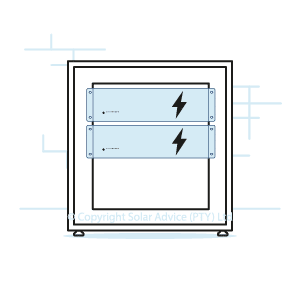
Cabinets are becoming readily available to store your batteries. They prevent debris from landing on your battery bank and also prevent damage,
particularly in high traffic areas.
Wall Mount
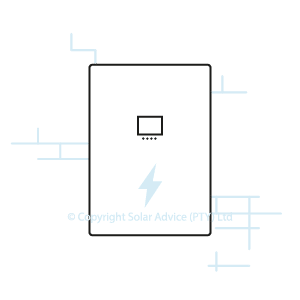
Some LiFePO4 batteries are wall-mounted. This is particularly appealing if you have minimal space to store batteries.
These batteries come with wall mountings.

Cable packs are also available for purchase, these are sometimes required depending on the battery brand.
Chapter 4
Lithium-ion Solar Batteries: Pricing
How much can you expect to spend

Are you holding your breath?
Go ahead and breathe.
The solar battery price depends on a few factors. Like brand, size, and type of battery.
LiFePO4 batteries cost more than lead-acid initially. But, due to their longer lifespans, you will actually save money in the long run.
You will be investing in a great product that will give you many years of use.
Lithium-ion technology offers upwards of a decade in daily charging and discharging. Its competitor offers around 3-5 years before you have to fork out for another backup system.
Below is a comparison table of lithium-ion and lead-acid deep cycle battery prices:
Lithium-ion |
Lead-Acid |
|
| Size | 2.4kWh (1.92kWh Usable) | 4.8kWh (2.4kWh Usable) |
| DOD | 80% | 50% |
| Cycles | 6000 6000 / 365 = 16.44 (Cycles / 1 year = Lifespan) |
1350 1350 / 365 = 3.70 (Cycles / 1 year = Lifespan) |
| Average Cost | R 13,000.00 | R 9,200.00 |
| Cost Per kWh | R 6.77 (R 13,000.00 / 1920W) |
R 3.83 (R 9,200.00 / 2400W) |
| Cost Per Year | R 790.75 (R 13,000.00 / 16.44 years) |
R 2,486.49 (R 9,200 / 3.70) |
- Look for the DOD. A good starting place is 80%
- The more cycles available, the longer your battery has the potential to last.
- A few brands offer a standard 7-year warranty with the option of registering the batteries for a 3-year extension, taking it up to 10 years. The warranty is important and should not be overlooked.
Lithium-ion Solar Batteries: What’s the Bottom Line?
If you want a product that is:
1. Scalable: Allows you to add more batteries should your needs increase. Never get tied down to specific storage size.
2. Modular: The modular design allows for neat stacking/mounting of the batteries.
3. Has Storage Accessories: Most LiFePO4 batteries are either wall-mounted or stackable. You can buy cabinets and brackets to store your batteries , ensuring a much neater and modern look.
4. More Efficient: LiFePO4 solar batteries are around 95% – 98% efficient . Lead-acid batteries are 80% – 85% efficient.
5. Has Increased Cycles: LiFePO4 offers around 5000+ cycles vs 300-500 cycles for AGM Batteries.
6. Has a Built-in BMS: Most Lithium Iron Phosphate Batteries have a built-in battery management system . The BMS monitors the health of your battery and protects the battery from damage.
7. Has a Stable Discharge Rate: LiFePO4 solar batteries have a slow discharge rate, which allows them to have constant storage capacity.
8. Competitive Pricing: Yes, the initial investment for a LiFePO4 battery is higher. But you must take the lifespan, ability, and performance into consideration. Once you understand the benefits of these great batteries, your decision will be an easy one.
If you are looking for the best solar battery money can buy , visit our Lithium Solar Batteries page. We stock solar batteries for home, office and holiday homes.
Lithium-ion Solar Batteries: Our Lithium-ion Options:
-
Dyness, Lithium-ion Batteries, Solar Batteries, Solar Power Products
Original price was: R21,275.00.R17,912.40Current price is: R17,912.40. inc VAT Read more -
Dyness, Lithium-ion Batteries, Solar Batteries, Solar Power Products
Original price was: R17,912.40.R14,950.00Current price is: R14,950.00. inc VAT Add to cart -
Dyness, Lithium-ion Batteries, Solar Batteries, Solar Power Products
Original price was: R8,797.50.R8,413.40Current price is: R8,413.40. inc VAT Add to cart -
Dyness, Lithium-ion Batteries, Solar Power Products
Original price was: R18,975.00.R17,825.00Current price is: R17,825.00. inc VAT Read more

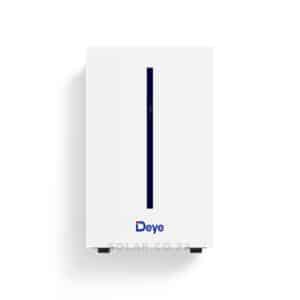
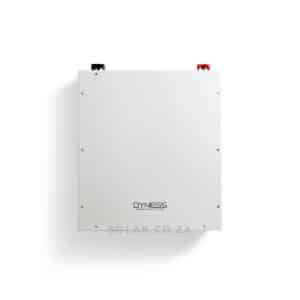
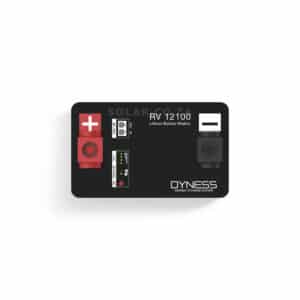
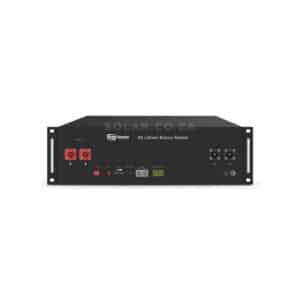
Hi
I currently have 18 x 105 Omnipower batteries in my battery bank, I am 100% off grid and would like to know if I want to replace my battery bank with Lithium-ion batteries , what size , model and how many do I need?
It is a 24V system.
Regards
Hi, you have 11kWh rounded up, because they’re Lead-Acid it works out to be 5.5kWh, to replace those I’d suggest 2 PylonTech US3000’s which will give you 5.6kWh, here’s the link https://solar.co.za/product/pylontech-us3000c-3-5kwh-lithium-ion-solar-battery
Hi Aubrey, I would suggest a Load Shedding kit to help in this situation.
To run your basics like lights, TV, fridge and modem for around 4 hours you will be better off with a 5kWh backup system https://solar.co.za/shop/solar-power/load-shedding-kits?inverter=5kw
5kWh will get you through 4 hours, I have this same kit and I never know when there is load shedding. Unless you have a flat with literally a TV, Modem and perhaps a couple of lights I would not suggest anything smaller.
The great thing about the Load Shedding kits we have is that you can add panels later for a complete solar solution, it’s a very worthy investment in the long run and the price per kW over a 15 year period with the fact you never have load shedding is something I would suggest looking at.
Hope that helps.
Morning, i need some assistance please, as you know we all have load shedding and i am looking for a solution to keep my house running, can you give me some advice on what will be the best way forward.
Hi
I currently have an inverter with 16 100ah deep cycle batteries, please advise what I would need to replace this similar power with lithium ion
Hi, how are they wired together? Are they in series or parallel?
Hi, I am in the process of purchasing a Tesla Powerwall 2. I am hesitating and know there are good options available locally like freedomwon. I don’t mind paying the premium for the Tesla. I see it as buying an iphone versus a cheaper smartphone. We pay a premium for iphones becuase ot comes with peace of mind that you get what you pay for. What is your opinion?
Hi I use 1.8kw per day what size 48v li irone battery do I need with 5kva inverter
Hi Tokkie,
The Pylon or Dyness 2.4kw battery @ 80% depth of depletion will offer 1.92kw in storage power.
Hi, the Tesla Pwerwall 2 is quite an impressive product but it also comes at a premium. We do have quality systems that can do what the Powerwall does at a better price point, one example is the Alpha ESS. This has a fantastic spec with everything you need to run a large household.